#I think Mayor sees art in a way in terms of ideas rather than skill level
Explore tagged Tumblr posts
Note
Don't feel Bad about your draws, Macaque is not that good in it too (he just lie about it)
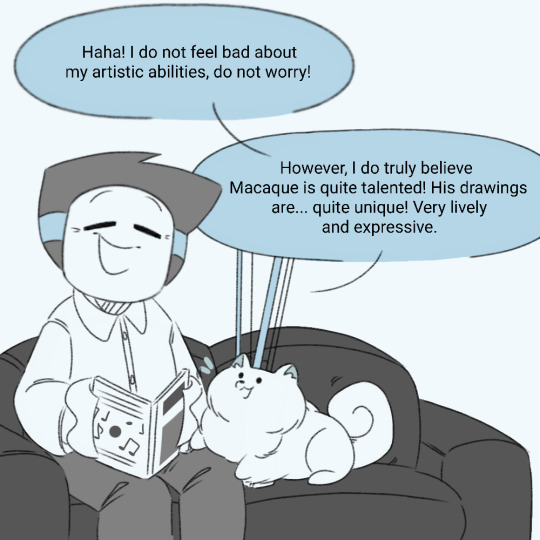
MASTER POST
Asks Start 💙🐶
Previous 💙🐶
Next 💙🐶
#lego monkie kid#lego monkie kid fanart#monkie kid#monkie kid fanart#lmk#lmk fanart#lmk mayor#monkie kid mayor#blue and violet#I think Mayor sees art in a way in terms of ideas rather than skill level#Macaque's ideas are very clear when he draws - even if it looks like shit he can clearly convey his point#especially with his self portraits#so Mayor thinks Macaque's is good at making a point when he draws#they themselves on the other hand? not really#When they drew themselves it was not clear that it is even them to begin with#and thats not because they suck qt drawing#its because they don't now how to convey a point or an idea - let alone express themselves#in fact this guy barely has ideas at all in general- they might be one of the least creative people in existence#so I guess what I'm trying to say in the tags (which I rant too much in) is that I have thought about this too much LMAO
41 notes
·
View notes
Text
January ‘20
I felt like trying this for a bit again.
Untitled Goose Game
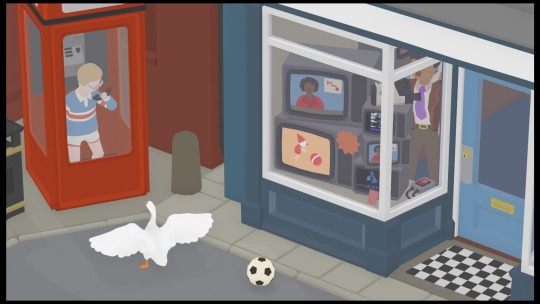
Where Journey and its ilk blew up the idea of a short, single-visit game, Untitled Goose Game feels closer to the next evolution of this ultra-focused style of design. It’s a perfect elevator pitch of a game - surmised exactingly in its abstract, and not even needing to commit to a ‘proper’ title… and yet more immediate and relatable than countless other games. Your aims are clear and simple, and a compact suite of commands elicits a range of responses from its environments and characters to help you achieve them. How one begets the other is just logical enough to work for its two hour duration, but does suggest it’s unlikely to have had scope to go much beyond this without repetitive tedium, or becoming bewilderingly obtuse. That’s not to say that it’s challenges are totally intuitive, or even that it’s free of moments where janky controls entangle you - but again, you’ll easily endure through it given how briefly you’re expected to stay. The primal appeal of being a horrible goose is easy to be ensnared by, and is neither overdone nor worn thin, once again thanks to the length of it. Its elegance and charm complements the simplicity of it all wonderfully, and though not revolutionary, or pushing any particular aspect of the medium to new highs, the quirk, laughs and originality of it is the type of bottled lightning that is unlikely to be replicated any time soon. Honk.
Wattam

It’s a game by Keita Takahashi. You can assume plenty; warmth, charm, whimsy, colour, humour - and you’d be right. Divorced of a big studio and the legion of other talent that comes with it, his solo work continues to be mechanically light and missing a few layers of polish, yet is simultaneously far more experimental and groundbreakingly humane than most anything you could care to mention. Trying to explain in regular video game terms what you do is somewhat redundant, but to at least give it a shot; you play a large green square - The Mayor - who’s initially alone, but slowly coerces its population back, repopulating the world through various interactions within it.
I’ll be straight with you: I’ve had to rewrite this passage, as some of the first sessions I spent with this drove me up the wall and lead to a less-than-favourable commentary. Fully aware that talking predominantly about how it plays was “doing it wrong”, I nevertheless took to highlight how I found the camera frustrating, the characters’ erratic and independent movement to be testing, and the rapid-fire sampling of children’s cries laid over the jazzy background music to be cacophonous and anxiety-provoking rather than joyous. That I persevered and made it through the rest of the game is not to say I don’t still harbour some negativity towards it, but the last portion of the game did do a far better job of bringing me around to its charms than those earlier moments where I felt a bit too much like I was wrestling with it. I knew I wanted to see it all and to love it; the idea of being on the outside of something so light being quite so glum, but it didn’t come quite as easily as I was expecting. Don’t be too put off, but perhaps don’t also expect it to be completely painless either.
Neo Cab
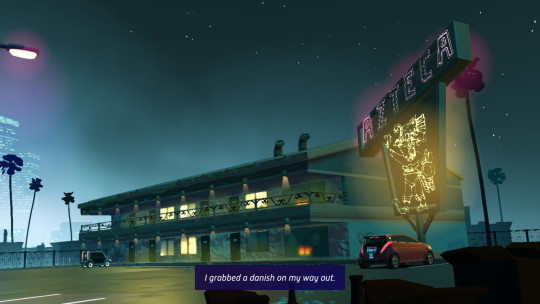
Neo Cab’s setting shines a miserably relatable light on a dystopian city and the people living within it. There’s an increasingly downtrodden population of gig economy workers, a police state whose corporate favouritism is not remotely subtle, and a growing number of people whose sentiment against this climate is rallying them together, and turning to action. There is not a lot of digging required to expose the game’s politics, or to join the dots to whom it really wishes were held to justice.
Normally when talking about visual novels, or even just narratively-focused ones, I tend to find myself on the back foot, expecting folks to turn off, and having to find ways to walk it back to more traditional game tropes. Here, I was actually quite pleased with how well Neo Cab defies any lack of interaction - to the point where I’d actually be pretty comfortable recommending this to near anyone. A big component of this is set up early on; a wearable device is forced upon your character that visibly broadcasts her current mood for all to see. As well as mood limiting what you’re willing to say (crucially though, not stopping you from contemplating these options), it’s also un-conveniently right there on her wrist for folks to see when they’ve hit a nerve. As a cab driver by trade, branching dialogue options you need to assess are incredibly frequent - and give your cues are often assuming, intrusive, or just plain rude - your management of them becomes all the more immediate and crucial. Ride quality influences your rating as a driver as well as your income, which in turn impacts which rides you can take, who you can meet, and who you can rely on in future. Sometimes your choices are simple, whereas other passengers may be more obtuse, or inadvertently land you in a quandary more moral in nature. It’s not a long game, and while I naturally don’t want to say too much, it does a good job of keeping the focus grounded on its key characters, who really make it all tick over nicely. I thought Neo Cab was pretty great - it’s got a simple but stylish look to it, and gives you just enough to think about.
Demon’s Tilt
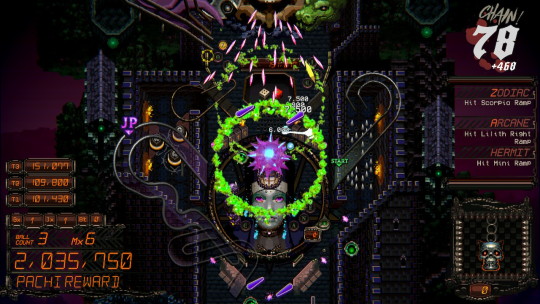
Pinball tables may not have changed much in the layman’s eyes over the years, but video game versions certainly have. In paying quite unsubtle homage to Naxat’s series of tables that blessed a number of 16-bit systems, the passage of near three decades has given Demon’s Tilt plenty of space to grow into. Larger, higher resolution screens gives us bigger play spaces and more detailed imagery, while increased technical grunt lends itself to a seemingly limitless crescendo of frenetic, often incomprehensible action. I mean, why not throw a little bullet hell into the mix? Goodness grief.
Given my particular fondness for Devil’s Crash, which to Demon’s Tilt is the clearest, most singular inspiration, I was naturally drawn to this. I’d played a little before in early access, but a more complete Switch version was appealing enough to revisit it. I was already safe in the knowledge that it’d managed to build upon and flatter my favourite pinball game without reducing itself to an imitation, but the option of portable play (with a FlipGrip, even) was particularly exciting. As it happens, trying to condense so much to a small screen wasn’t quite such the modern convenience I’d hoped - it’s a neat showcase, but quite impractical to actually play with. Not thrusting yourself within an inch of the screen and having to squint may give a smidgen more a fighting chance, but a bigger display also allows you to appreciate the slick blend of neon effects spewing themselves over the striking gothic imagery. The music contributes yet more welcome intensity to things, and though I’ve begrudged a few near misses and unfortunate bounces, in calm retrospect it’s clear the this is far more a reflection of my skill rather than any lack in ball physics. For those who are practised in ways I am not, the table itself has plenty of opportunity to flex your muscle, but even though my games aren’t the feats of endurance I’d wish for, I’m still coming away each time clamouring to go straight back in.
198X
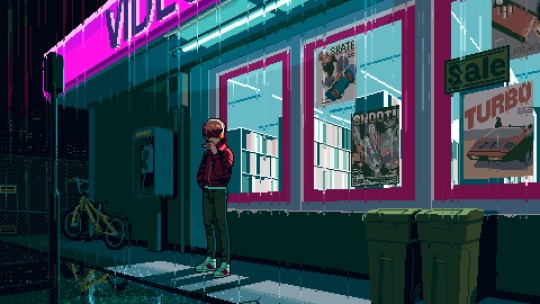
I missed this game’s crowdfunding attempts, but after seeing its trailer - a moody and romanticised nod to all things 80s arcade culture - it was very clear this was making a direct appeal to my sensibilities. It’s a coming of age story about a bored suburban teen, whose discovery of the local arcade ‘changes everything’. Now, I love arcades far more than most, but even I found the story to be over-egged. The Kid’s monologuing through the game’s cut-scenes jumps at such breakneck speed that it genuinely made me feel uncomfortable about their state of mind. Pre-arcade, all is miserly and monotone, whereas the escapism they indulge in after this discovery is worryingly unhinged. The pixel art propping them up may be quite tasty, but I think most people will find the story being pushed to be a touch cringeworthy.
The game that’s book-ended by these scenes are actually a series of mini-games, each clearly inspired by a particular 80s title. In short clips and stills, you could be fooled into thinking these are not just dutifully upgraded, but maybe even improved homages to the given classics. Visually, yes, there is some argument to be made here as there is some terrific pixel artistry being conducted here, but as there’s only about 15 minutes of each to play, it’s no surprise that some corners have had to be cut. Generally speaking, the balance of each isn’t quite so nuanced, and unsurprisingly this leans towards them being easier than you’d expect, but there’s specific shortcomings in each too. For example: definitely-not-Final Fight has some shocking collision detection, and of particular disappointment for myself, definitely-not-Outrun has but one gear, and hardly any impression of speed. While not fatal flaws, my point is simply that you’d not choose to play these over the original games they intend to pay their respects to. A second part being teased at the shortly-reached end is likely a downer for those expecting value, but I think it’s two-hour runtime is probably just about right considering it’s best viewed as a novelty.
0 notes